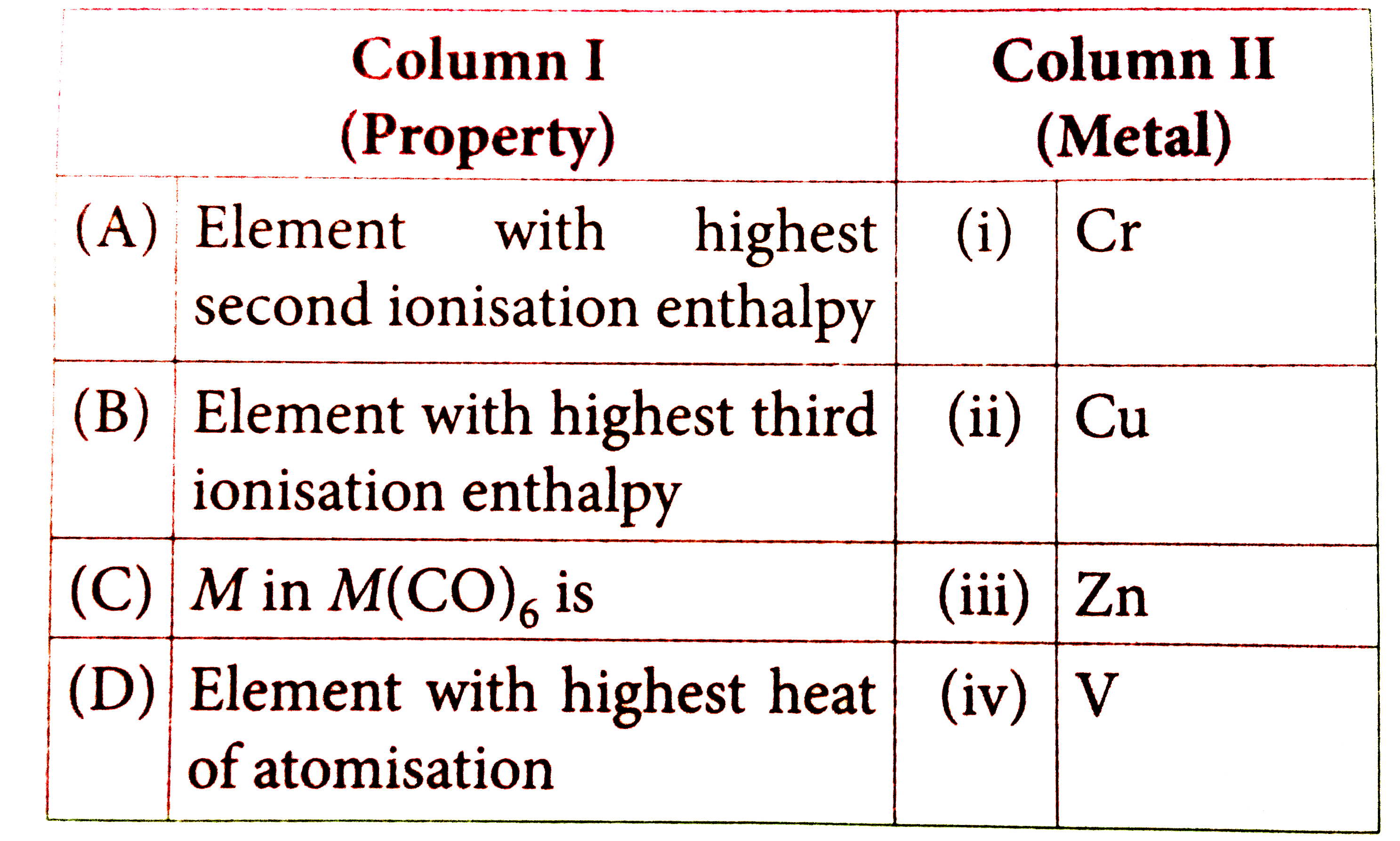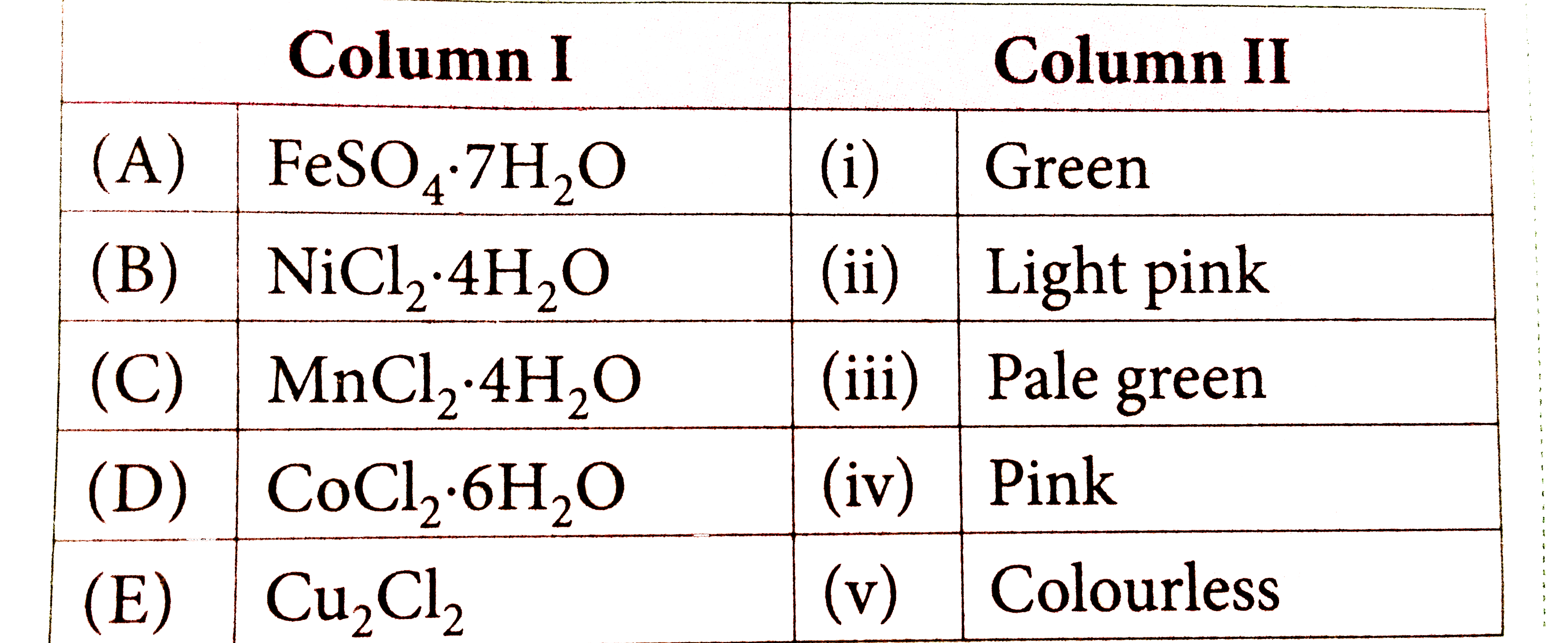Complete Solutions to General Properties Of The Transition Elements of chapter THE D- AND F- BLOCK ELEMENTS of Class 12 book with complete answers and questions
| Class 12 | CHEMISTRY |
| Chapter | THE D- AND F- BLOCK ELEMENTS |
| NCERT FINGERTIPS | General Properties Of The Transition Elements |
| Number Of Questions | 39 |
| Academic Year | 2023-24 |
The melting points of Cu, Ag and Au follow the order
04:09View SolutionThe melting point of copper is higher than that of zinc because
03:18View SolutionDue to lanthanoid contraction which of the following properties is not expected to be similar in the sme vertical columns of second and third row transition elements ?
07:16View SolutionZr(Z=40) and Hf(Z=72) have similar atomic and ionic radii because of:
01:44View SolutionThe second and third row elements of transition maetals resemle each other much more than they resemble the first row because of
08:08View SolutionReactivity of transition elements decreases almost regularly from Sc to Cu because of
09:10View SolutionWhich of the following is not corrextly matched with the given example ?
View Solution`Cu^(+)` ion is not stable in aqueous solution because because of dispropotionation reaction. `E^(@)` value of disproportionation of `Cu^(+)` is
`[E_(Cu^(2+)//Cu^(+))^(@)=+ 0.15 V, E_(Cu^(2+)//Cu)^(@)=0.34 V]`02:55View SolutionThe first ionisation energies of the elements of the first transition series `(TitoCu)`
00:54View SolutionMatch the column I with column II and mark the appropriate choice.
 11:46View Solution
11:46View SolutionIdentify the species in which the metal atom is in +6 oxidation state.
02:30View SolutionIn which of the following compounds manganese has oxidation number equal to that of iodine in `KIO_4`?
04:05View Solution`E_(Mn^(3+)//Mn^(2+))^@`is highly positive than that of `E_(Cr^(3+)//Cr^(2+))^@orE_(Fe^(3+)//Fe^(2+))^@` because
11:29View SolutionThe correct order of `E_(M^(2+)//M)^(@)` Values with negative sign for the four successive elements `Cr, Mn, Fe` and `Co` is:
03:02View SolutionWhich of the following d-block element has half - filled penultimate as well as valence subshell ?
02:30View Solution`Fe^(3+)` compounds are more stable than `Fe^(2+)` compounds because
02:35View SolutionThe salts of Cu in +1 oxidation state are unstable because
03:23View SolutionIn which of the following pairs of ions, the higher oxidation state in aqueous solution is more stable than the other?
I. `TI^(+), TI^(3+)` II. `Cu^(+),Cu^(2+)`
III. `Cr^(2+),Cr^(3+)` IV. `V^(2+),VO^(2+)(V^(4+))`View Solution`CuSO_4` is paramagnetic while `ZnSO_4` is diamagnetic because
03:49View SolutionWhich of the following transition metal ions has highest magnetic moment ?
04:14View SolutionSelect the correct option, among Sc(III) , Ti(IV), Pd(II) and Cu(II) ions
03:46View SolutionThe correct order of the number of unpaired electrons in the ions `Cu^(2+), Ni^(2+), Fe^(3+)`, and `Cr^(3+)`is
06:04View SolutionCalculate the magnetic moment of a divalent ion in aqueous solution if its atomic number is 25.
01:13View SolutionArrange the following in increasing value of magnetic moments.
(i) `[Fe(Cn)_6]^(4-)` (ii) ` [Fe(CN)_6]^(3-)`
(iii) `[Cr(NH_3)_6]^(3+)` (iv) `[Ni(H_2O)_4]^(2+)`06:07View SolutionWhich of the following statements is not correct about magnetic behaviour of substances ?
06:31View SolutionThe number of unpaired electrons in gaseous species of `Mn^(3+), Cr^(3+)` and `V^(3+)` respectively are………….and most stable species is…………..
03:40View SolutionWhich of the following arrangements represent the correct order of the property stated against it ?
(i) `Ni^(2+) lt Co^(2+) lt Fe^(2+) lt Mn^(2+)` : ionic size
(ii) `Co^(3+) lt Fe^(3+) lt Cr^(3+) lt Sc^(3+)` : stability in aqueious solution
(iii) `Sc lt Ti lt Cr lt Mn` : number of oxidation states
(iv) `V^(2+) lt Cr^(2+) lt Mn^(2+) lt Fe^(2+)` : paramagnetic behaviour04:31View SolutionMatch the column I with column II and mark the appropriate choice.
 08:33View Solution
08:33View SolutionWhich of the following transition metal ions is colourless ?
02:48View SolutionAmongst `TiF_6^(2-), CoF_6^(3-), Cu_2Cl_2" and " NiCl_4^(2-)`, which are the colourless species ? (atomic number of Ti = 22 , Co = 27, Cu = 29, Ni = 28)
04:57View SolutionWhich of the following compounds is not coloured ?
04:31View SolutionCompound that is both paramagnetic and coloured is:
03:17View SolutionMost of the transition metals exhibit
(i) paramagnetic behaviour
(ii) diamagnetic behaciour
(iii) variable oxidation states
(iv) formation of coloured ions04:21View SolutionFor `Zn^(2), Ni^(2+), Cu^(2+) and Cr^(2+)` which of the following statements is correct ?
04:23View SolutionColour of transition metal ions are due to absorption of some wavelength. This results in
05:11View SolutionWhich group contains coloured ions out of the following ?
1. `Cu^+` 2. `Ti^(4+)` 3. `Co^(2+)` 4. `Fe^(2+)`04:09View SolutionTransition metals make the most efficient catalysts because of their ability to
04:29View SolutionInterstitial compounds are
02:05View SolutionTransition elements form binary compounds with halogens. Which of the following elements will form `MF_(3)` type compounds?
02:10View Solution
General Properties Of The Transition Elements questions and complete solutions for chapter THE D- AND F- BLOCK ELEMENTS of NCERT FINGERTIPS CHEMISTRY (HINGLISH) of Class 12
